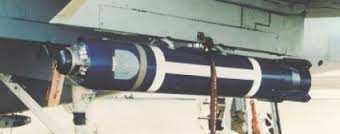BLU-80/B
Bigeye was the code name for a 500-pound binary chemical bomb designed by the U.S. navy for the delivery of VX nerve agent. VX is an extremely toxic synthetic chemical compound in the organophosphorus class, specifically, a thiophosphonate.
Binary refers to the concept of using two nonlethal but poisonous substances that are mixed in flight to produce a lethal nerve agent. This was done to ensure safer storage and handling of chemical munitions. Munitions already filled with chemical agents—so-called unitary weapons—had started to leak in the 1970s, and the Department of Defense was well aware of the negative public response to the dangers of these unitary chemical weapons. The Department of Defense needed a weapon that citizens would accept.
The Bigeye concept was conceived in 1959. Testing on Bigeye started in 1972, and about 200 test articles were produced at Pine Buff Arsenal, Arkansas. (Production never commenced, however, because the United States and the Soviet Union agreed to a chemical weapons destruction plan in 1990.) One canister of this binary weapon would be stored separately from the bomb itself and added just prior to flight (the bomb was to be delivered by plane). This separation would have extended the storage shelf life of the bomb and eased munitions maintenance requirements. Bigeyes were to be carried by tactical fighters, such as the A-6 and F-111, and they were to be used to attack second-echelon forces such as airfields and ammunition dumps to disrupt enemy operations behind the front lines.
General Accounting Office investigations uncovered fusing, mixing, and detonation problems with Bigeye, which led the U.S. Senate, especially Senator Richard Pryor (D-Ark.), to withhold funding and production go-ahead for the Bigeye bomb. There were two other binary chemical weapons in the U.S. arsenal: a multiple-launch rocket system submunition that never reached the prototype stage, and the 155-millimeter artillery projectiles called M-687, which did reach full-scale production.
The originally proposed deployment of the Bigeye bombs to Europe led to further controversy. The Belgian government nearly fell over the question, and the West German government only approved the deployment in a subministerial forum. A full ministerial approval would have led to a parliamentary debate that the government in Bonn did not want on the heels of the bruising Intermediate Nuclear Force deployment debate over deployment of American nuclear weapons on European soil. The European NATO allies were also disturbed by the adoption of the AirLand battle doctrine, which called for the use of chemical and nuclear weapons to achieve victory over Warsaw Pact forces in the event of war on the inter-German border.
With the signing of the Chemical Weapons Convention, the Pine Buff facility (where Bigeyes were produced) was inspected and then sealed in 1997 by the Organization for the Prohibition of Chemical Weapons, the implementing body established by the convention.
References 98th Congress, 1st Session, 13 July 1983; page S-9804, vote no 184, Omnibus Defense Authorization/Binary Chemical Weapons. 100th Congress, 1st Session, 24 September 1987; page S- 12704, vote no. 269, Defense Authorization Bill/Bigeye Binary Chemical Bomb. Badelt, J., Chemische Kriegsfuehrung—Chemische Abruestung: Die Bundesrepublik Deutschland und das Pariser Chemiewaffen-Uebereinkommen (Berlin: Berliner Verlag, 1994). Hernahan, John F., “The Nerve Gas Controversy,” The Atlantic Monthly, September 1974, pp. 52–56. Zanders, J. P., “The Debate on Binary Chemical Weapons in Belgium: The Act of 11 April 1962 Revisited,” Vredeonderzoek 7 (Brussels: Vrije Universiteit Brussel, December 1992).
